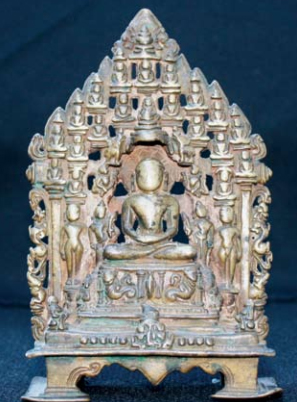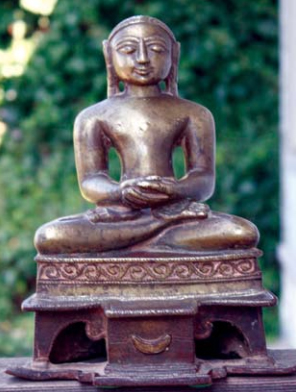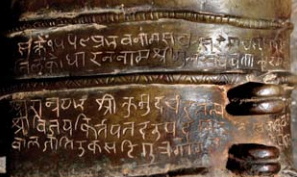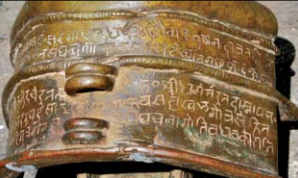
Centre of Jaina Studies Newsletter: SOAS - University of London
The two inscriptions discussed here seem more than usually puzzling: it would be interesting to know whether others can suggest better solutions. They are from the personal collection of Thomas Perardi, to whom we are indebted for careful and detailed photography.
The complex shrine, 18-19 cm. high, with twentythree Jinas surrounding the central figure, is thus a standard covīsī structure (I am grateful to Gerd Mevissen for confirmation of the count, inclusive of the standing and lower seated figures). (Figure 1) The main figure, with emblematic bull, is evidently Ṛṣabha. On the back is a brief and curiously beheaded inscription. (Figure 2) A straightforward reading meru śrīpralamatinīta(ṃ?) yields no sense, nor does -prala[ṃbh]avinītaṃ or other guesswork. The ordinary meaning of pralambha 'deceit' is hardly applicable, and the gloss '(act of) obtaining' that has been attributed to -pralambha in the Rāmāyaṇa is belied by an evidently correct northern reading -upalambha (where the 'critical' edition, 5.65.36, has a weak Vulgate emendation). The word vinīta is glossed as 'merchant' in Hemacandra's Anekārthasaṃgraha, etc., and we might ignore its possible final anusvāra: but 'Pralama' and the like are unconvincing as a name for such a donor. The fact that meru is asymmetrically positioned could imply that it refers to the structure of the icon and is unconnected with the subsequent dedication.
The single seated figure may be identified by the crescent moon as Candraprabha: but the inscription around the back of its pedestal gives no support. (Figure 3) It begins, as it means to go on, with a misreading, the copyist having apparently failed to recognize an unfamiliar combination of Śaka era and Jupiter-cycle dating, such as is to be found in southern manuscripts (Catalogue of the Jaina Manuscripts of the British Library, I, 163). The final numeral in the date is also uncertain, but resembles a form of 9, rather than an 8.
In the following transcript, round brackets denote a superfluous letter; square brackets denote omitted, erroneous, or illegible letters and syllables; ka indicates a deleted ka; and bha° is the abbreviation of bhaṭṭāraka (head of sect). (Figures 4 and 5)
sak(r)e 1559 prabhava-nāma-sa[ṃ]vatsare māghasudha-13 gurau vāre puṣ[y]a-nakṣatra-ta[d]dine
nilako[d]dhāra[ṇ]a-nāma-śrīM[ū]lasaṃghaBa[l]ā[t]kāraga[ṇ]a-Sar[a]svat[ī]ga[c]cha- Kuṃdaku[ṃd]a-
śrīrānvaya-bha[°]-śrīKumudacaṃdra tatpaṭ[ṭ]e bha°- śrīDharma[c]aṃdra tad-āmnāya bha°
śrīVijayak[ī]rt[i][s] tad(a)-upade[ś]āt [....]sva- vāka[s(a)t]avya svabha-gotra sehita-
vāla-jāti ukasaṭi[p]utra gā[ṃ]gasaripa[..]acanāgoti- vadhavako dāti
'On the day of the constellation Puṣya, on Thursday, 13th of the waxing moon in Māgha in the (Jovian) Year called Prabhava in the Śaka Year 1559 [A.D. 1638],

Figure 1

Figure 2
in the Sarasvatī branch of the Balātkāra sect in the nilakauplifting Mūla congregation, on the instructions of Bhaṭṭāraka Vijayakīrti in the tradition of Bhaṭṭāraka Dharmacandra, in the seat of Bhaṭṭāraka Kumudacandra in the glorious tradition of Kundakunda, (the following), having their dwelling in (the town of) [....], in the Svabha family in the Sehitavāla caste, Gāṅga and............, the sons of Ukasaṭi, dedicate (the image).'
The text specifies a year Prabhava of the cycle of 60 'years' of Jupiter. According to An Indian Ephemeris, no Prabhava year fell anywhere near Śaka 1559; nor does the Vikrama year 1559 provide a solution. Otherwise, Thursday, 18 January, A.D. 1638, meets most criteria: and it is hard to see how any more satisfactory results can be obtained for the few Jovian dates given in the British Library catalogue. The epithet nilaka- applied to the Saṃgha is unclear: neither 'uplifting the abode' (if for nila[y]a-uddhāraṇa) nor 'eradicating persons of the blue leśyā' (if for *n[ī]laka-uddh[a]raṇa) seems plausible. The fifth and final line may be expected to be listing the names of beneficiaries (that had possibly been illegible to the copyist), closing with a final dedicatory orgdāti, perhaps for (a)dāt. A probable two syllables giving the name of their residence seem abraded beyond recall, and one conjunct (pa[..]aca) seems indecipherable. It is, however, pleasing that these two interesting artifacts can be recorded here for posterity.

Figure 3

Figure 4

Figure 5
JC Wright is Emeritus Professor of Sanskrit at SOAS.
 Prof. J.C. Wright
Prof. J.C. Wright